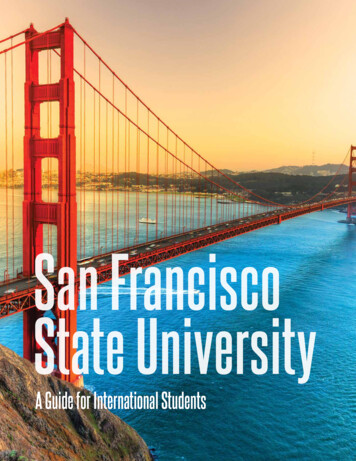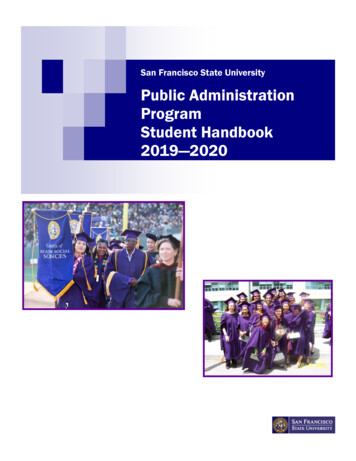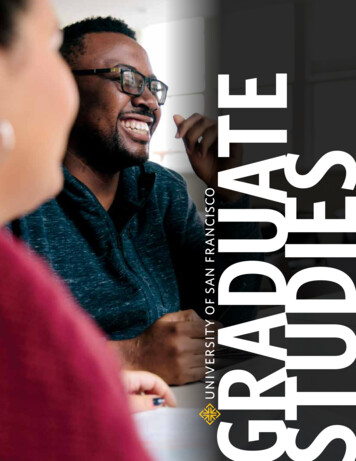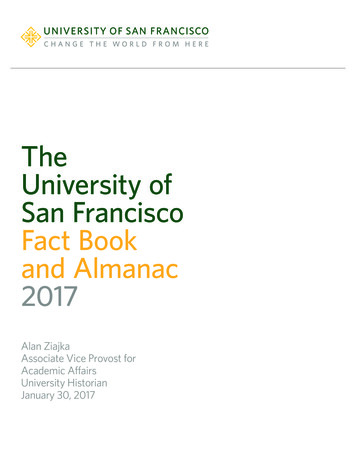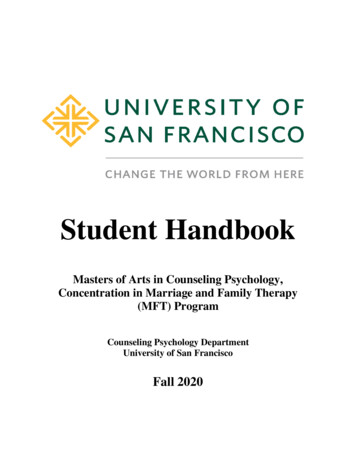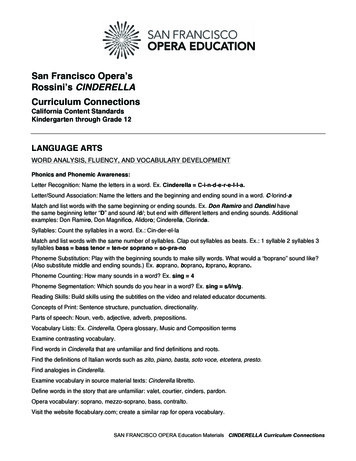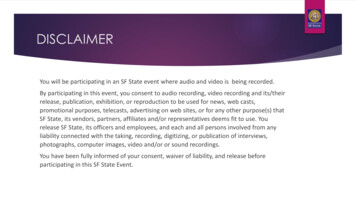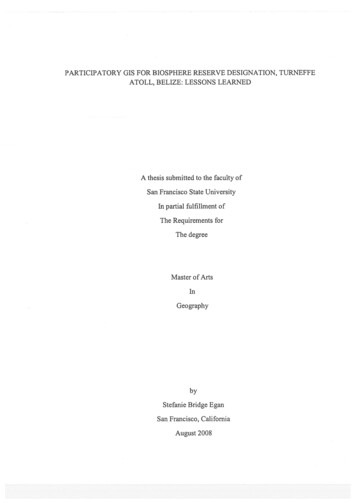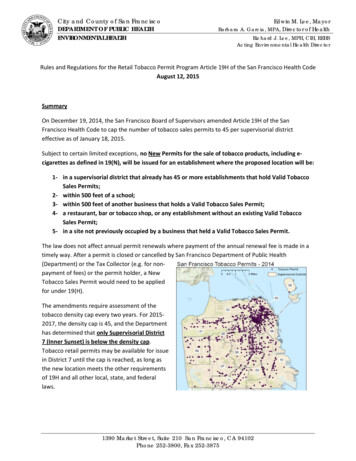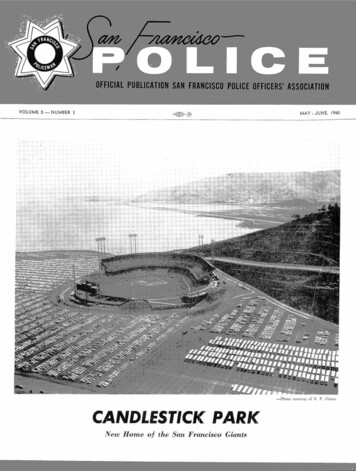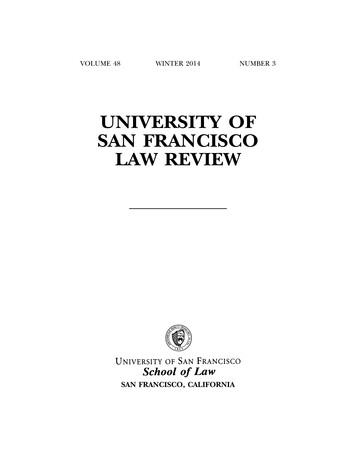
Transcription
VOLUME 48WINTER 2014NUMBER 3UNIVERSITY OFSAN FRANCISCOLAW REVIEWSAN FRANCISCO, CALIFORNIA
Cite as—U.S.F. L. REV.Copyright 2013 University of San Francisco School of LawThe University of San Francisco Law Review publishes articles, book reviews, and studentcommentaries and casenotes. The views, opinions, and conclusions expressed herein arethose of the authors and not of the Review or the University of San Francisco. The Review ispublished quarterly in the summer, fall, winter, and spring by the students of the University of San Francisco School of Law, Kendrick Hall, 2130 Fulton Street, San Francisco, CA94117-1080; e-mail usflrev@usfca.edu; (415) 422-6154. Citations conform to The Bluebook(19th ed. 2010), copyright by the Columbia, Harvard, and University of Pennsylvania LawReviews, and the Yale Law Journal. The Review invites the submission of unsolicited manuscripts. We regret that such manuscripts cannot be returned except upon receipt of postage and handling fee of 3.20 for priority mail.Subscription price, 45.00 per year; individual back issues for volumes 37–40, 15.00each. For back issues prior to volume 37, inquire of Wm. Hein & Co., 1285 Main Street,Buffalo, New York 14209. Back issues are available in PDF format through HeinOnline(http://heinonline.org/). If the subscription is to be discontinued at expiration, notice tothat effect should be sent or the subscription will be renewed. One month’s notice isnecessary to effect change of address. Microfilm copies of all issues available from University Microfilms International, 300 North Zeeb Road, Ann Arbor, MI 48106.Students at the University of San Francisco School of Law also publish the U.S.F. Maritime Law Journal. Each edition of the U.S.F. Maritime Law Journal contains articles that covera wide range of admiralty issues. Subscription inquiries may be sent to U.S.F. MaritimeLaw Journal, University of San Francisco School of Law, 2130 Fulton Street, San Francisco,CA 94117-1080; (415) 422-2766.The University of San Francisco Law Review is committed to a policy of equal opportunityand does not discriminate in employment, admission, promotion, or retention on the basisof sex, sexual orientation, race, color, religious creed, national origin, or disability. It isalso expected that employers using the School of Law Placement facilities abide by thesestandards and take positive steps to assure that no such discrimination occurs in hiring,promotion, or compensation for work assignments.The University of San Francisco Law Review (ISSN 0042-0018) is published quarterly for 45.00 per year by the University of San Francisco School of Law, Kendrick Hall, 2130Fulton Street, San Francisco, CA 94117-1080. Periodicals postage paid at San Francisco,CA and additional mailing offices. POSTMASTER: Send address changes to University ofSan Francisco Law Review, Kendrick Hall, 2130 Fulton Street, San Francisco, CA 941171080.www.usfca.edu/law/lawreview/ii
UNIVERSITY OF SAN FRANCISCO LAW REVIEWVolume 48Winter 2014Number 3BOARD OF EDITORSEditor-in-ChiefJESSE D. GOSSETTManaging EditorJOSEPH GRUBERExecutive EditorMEGAN C. MCLETCHIETechnical EditorEMILY POOLESymposium EditorELIF SONMEZArticles EditorsVERONICA A. FRANCISJEREMY F. KOOSEAN M. MCNEALISERIK C. SHALLMANComments EditorsDAVID FUJIMOTOTANNER K. JACOBSKEREN H. VANISISENIOR STAFF MEMBERSROBERT BREWINGTONMICHAEL BIGGANSALYSSA BUSSEYREBECCA DAMESMARK J.G. DESROSIERSLILLY BAIRD MCKENNAADRIENNE GARCIAPATRICK GROCHMALWINSTON K. HUKEVIN BRYCE JACKSONSIMARJIT KAURBRIAN KEEGANADA B. LIUJULIE LODEREILEEN MAGTIBAYALISHA MEYERCOREY MUELLERIAN T. O’BANIONDARREN J.M. ORRFRANCESCA M. PERETTILAUREN SAWCHENKOCHRISTOPHER P. VACCAREZZAESTHER WILCHAMY A. YUNGSTAFF MEMBERSPAREESA ASHABIFRANCINE BENDATMILA BUCKNERALEXANDER J. BUKACSOPHIA COHNOCTOVIA YUKI CRUSESOULA ELLENIKIOTISJACQUELINE V. FORNICLAUDIA V. GARCIAJENNIFER L. GRIMESALEXANDER GUNEYMICHAEL H. HEWITT, JR.MELISSA HONGADAM KARAGEORGEALEEN KOUMRIQIANWILSON LAUSIMON LEVYOLIVIA C. MCNEEGUY E. NOYESALYSE ANN PACHECOMAGDALENA RIDLEYADVISORSALICEBRITTANY E. ROBERTOQUENTIN ROBERTSALEX SHARPTENETTE SMITHJENNIFER L. STA.ANANICOLE SYZDEKLOGAN TILLEMAPATRICK TUCKEVANN WHITELAMCAMILLE WOLPEELENA YAKUBOVASYMPOSIUM ADVISORJOHN M. ADLER, TIM IGLESIAS,KASWAN, LEE RYAN, MICHELLE TRAVISAssistant to the EditorsKENJI A. QUIJANOiiiJOSHUA P. DAVIS
UNIVERSITY OF SAN FRANCISCOSCHOOL OF LAWREV. STEPHEN A. PRIVETT, S.J., B.A., M.A., Ph.D., President of the UniversityJENNIFER E. TURPIN Ph.D., Provost and Vice President for Academic AffairsJOHN D. TRASVIÑA, A.B., J.D., Dean of the School of LawJOSHUA PAUL DAVIS, B.A., J.D., Associate Dean for Academic AffairsMICHELLE TRAVIS, B.A., J.D., Associate Dean for Faculty ScholarshipELIZABETH J. BENHARDT, B.A., Assistant Dean for Academic ServicesERIN DOLLY, B.A., J.D., Assistant Dean for Student AffairsBLAKE GRENIER, B.S., M.Ed., Senior Director for AdministrationFACULTYJOHN M. ADLER, A.B., J.D., Professor of LawSHALANDA BAKER, B.S., J.D.,LL.M., Associate Professor of LawWILLIAM W. BASSETT, A.B., M.A., S.T.L., J.C.D., J.D., Professor of Law EmeritusJEFFREY S. BRAND, A.B., J.D., Professor of Law and Chairman of the Center for Law and GlobalJusticeJOSHUA PAUL DAVIS, A.B., J.D., LL.M., Associate Dean for Academic Affairs, Director of the Centerfor Law and Ethics, and Professor of LawCONSTANCE DE LA VEGA, B.A., J.D., Professor of Law and Academic Director of InternationalProgramsJOHN F. DENVIR, B.A., LL.B.,LL.M., Research Professor of the Law and HumanitiesREZA DIBADJ, S.B., M.B.A., J.D., Professor of LawPETER J. DONNICI, B.A., J.D., LL.M., Professor of Law EmeritusDOLORES A. DONOVAN, B.A., J.D., Research Professor of International Law and DevelopmentH. JAY FOLBERG, B.A., J.D., Professor of Law EmeritusDAVID J. FRANKLYN, B.A., J.D., Professor of Law, Director of the LL.M. Program in IntellectualProperty and Technology Law and Director of the McCarthy Institute for Intellectual Propertyand Technology LawSUSAN A. FREIWALD, B.A., J.D., Professor of LawJACK I. GARVEY, B.A., J.D., Professor of LawTRISTIN GREEN, B.S., M.S.J., J.D., Professor of LawJOSEPH T. HENKE, B.A., J.D., LL.M., Professor of Law EmeritusBILL ONG HING, A.B., J.D., Professor of LawPETER JAN HONIGSBERG, B.A., J.D., Professor of LawDEBORAH M. HUSSEY FREELAND, B.A., Ph.D., J.D., Associate Professor of LawTIM IGLESIAS, B.A., M.A., J.D., Professor of LawALICE KASWAN, B.S., J.D., Professor of LawVIRGINIA KELSH, B.A., M.S.L.S., J.D., Professor of Law Emerita and Director Emerita of the DorraineZief Law LibraryDANIEL LATHROPE, B.S.B.A., J.D., LL.M., E.L. Wiegand Distinguished Professor in TaxRICHARD A. LEO, A.B., M.A., Ph.D., J.D., Professor of LawRHONDA MAGEE, B.A., M.A., J.D., and Professor of LawMAYA MANIAN, B.A., J.D., Professor of LawJ. THOMAS MCCARTHY, B.S., J.D., Senior Professor of Law and Founding Director of the McCarthyInstitute for Intellectual Property and Technology LawPAUL L. MCKASKLE, B.A., J.D., Professor of Law EmeritusSHARON A. MEADOWS, B.A., M.A., J.D., Professor of Law and Director of the Criminal and JuvenileJustice ClinicsRONALD H. MICON, B.A., J.D., Professor of LawSUZANNE E. MOUNTS, B.A., J.D., Professor of LawJULIE NICE, B.S., J.D., Herbst Foundation Professor of LawMARIA LINDA ONTIVEROS, A.B., MILR, J.D., J.S.D., Professor of LawBRUCE M. PRICE, B.A., J.D., Ph.D., Professor of LawC. DELOS PUTZ, B.A., J.D., Professor of Law EmeritusDAVID L. RATNER, A.B., LL.B., Professor of Law EmeritusELDON H. REILEY, B.S., J.D., Professor of Law EmeritusJOSHUA D. ROSENBERG, B.A., Ed.D., J.D., LL.M., Professor of LawSTEVEN F. SHATZ, A.B., J.D., Phillip and Muriel Barnett Professor of Trial AdvocacyROBERT E. TALBOT, B.A., J.D., Professor of Law and Director of the Mediation, Investor Justice, andInternet/Intellectual Property ClinicsMICHELLE TRAVIS, B.A., J.D., Associate Dean for Faculty Scholarship and Professor of LawRONALD E. WHEELER, B.A., J.D., MLIS, Director of the Dorraine Zief Law Library and AssociateProfessor of Lawiv
Not “For God and Country”: AtheistMilitary Chaplains and theFree Exercise ClauseBy ANTONY BARONE KOLENC*IntroductionTHROUGHOUT HISTORY, CHAPLAINS HAVE MINISTERED tothe religious needs of military members. They provide “spiritual careand the opportunity for [military] members, their families, and otherauthorized personnel to exercise their Constitutional right to the freeexercise of religion.”1 The motto of U.S. Army chaplains captures thisfundamental spiritual core: Pro Deo et Patria 2—“For God and Country.”3 But nontheists4 are now demanding their own chaplains as areligious accommodation. Although some quip that an atheist chap-* Antony Barone Kolenc, JD, University of Florida College of Law, is an AssistantProfessor of Law at Florida Coastal School of Law, where he teaches Constitutional Law.He served as a Lieutenant Colonel in the Air Force Judge Advocate General’s Corps beforeretiring in 2012. The views expressed in this Article are those of the author alone and donot reflect the official policy of the Department of Defense (“DOD”) or Florida CoastalSchool of Law. Professor Kolenc also acknowledges Noah B. Benton and Sara L. Goodinfor their keen research assistance and contributions to this paper.1. U.S. DEP’T OF THE AIR FORCE, POLICY DIRECTIVE 52-1, CHAPLAIN SERVICE para. 1(2006) [hereinafter AFPD 52-1].2. U.S. Army Chaplaincy Mission, CHAPNET, / (last visited May 27, 2014).3. Randy Murrey, Army Chaplains Corps: Serving ‘God and Country’ for 234 Years with25,000 Chaplains, U.S. ARMY (July 9, 2009), 00-chaplains/.4. This Article uses the terms atheists, nontheists, and secularists to refer to those “whotake negative or skeptical positions on the existence of superhuman beings and supernatural powers.” Nelson Tebbe, Nonbelievers, 97 VA. L. REV. 1111, 1117 (2011). No disparagement is meant by these terms, which are also used by the group’s own members. Althoughsome argue followers of Eastern religions, such as Buddhism, are also nontheists, this Article, similar to Professor Tebbe, limits the scope of the term to traditional nonbelievers. Seeid. at 1118 (defining nonbelievers as atheists, agnostics, and “most secular humanists, freethinkers, and the like—to the degree that they take negative or skeptical positionson [spiritual] issues”).395
396UNIVERSITY OF SAN FRANCISCO LAW REVIEW[Vol. 48lain is an “oxymoron,”5 the issue is no laughing matter. The quest fornontheist chaplains slices to the core of how religion is defined underthe First Amendment. This Article critically examines whether theFree Exercise Clause6 should be used to accommodate the demandfor atheist military chaplains and proposes an alternative to admittingatheist chaplains into the historically faith-based chaplaincy.The push for atheist military chaplains is of recent vintage,7emerging in 2011 as the latest salvo in the battle of the New Atheists8against a military structure they view as beholden to Christianity.95. 159 CONG. REC. H4936, H4942-43 (daily ed. July 23, 2013) [hereinafter House Debate] (comments of Rep. Jim Bridenstine (R., OK) and Rep. John Fleming (R., LA)); KenKlukowski, Atheists Want Their Own Military Chaplains, BREITBART (June 5, 2013), /Atheists-Want-Their-Own-MilitaryChaplains (“No one has yet offered an explanation of how an atheist chaplain is anythingother than an oxymoron . . . .”).6. U.S. CONST. amend. I. A topic this vast could engender other lengthy articles focusing on related inquiries under the Religious Freedom Restoration Act of 1993, Pub. L.No. 103-141, 107 Stat. 1488 (1993) (codified at 42 U.S.C. §§ 2000bb–2000bb-4) or the Establishment Clause, U.S. CONST. amend. I. But I believe the discussion should begin withthe Free Exercise Clause. Thus, I will limit the scope of this Article to that examination.7. See Brad Hirschfield, Why the Military Needs Atheist Chaplains, FAITH STREET (Nov.21, 2011), the-military-needs-atheist-chaplains/10176. The mainstream news media first began to report in earnest on thecall for atheist military chaplains near the end of 2011. Id. The issue garnered furtherattention a month later when National Public Radio ran a major story on one advocacygroup’s efforts to convince the military to authorize atheist chaplains. See All Things Considered: Chaplains Wanted for Atheists in Foxholes, NPR (Dec. 4, 2011) [hereinafter ChaplainsWanted for Atheists in Foxholes], available at wanted-for-atheists-in-foxholes.8. Simon Hooper, The Rise of the ‘New Atheists,’ CNN (Nov. 9, 2006), eism.feature/. Popular authors, such asRichard Dawkins and Christopher Hitchens, were pioneers of the modern movementdubbed “New Atheism.” Id. They shared “a belief that religion should not simply be tolerated but should be countered, criticized and exposed by rational argument wherever itsinfluence arises. . . . Their tone is overtly confrontational rather than gently persuasive.” Id.A subset of this movement, which includes organizations such as the Military Association ofAtheists and Freethinkers (“MAAF”) and the Military Religious Freedom Foundation(“MRFF”), has targeted religion in the military. See MILITARY ASS’N OF ATHEISTS &FREETHINKERS, http://militaryatheists.org (last visited Feb. 10, 2014); MILITARY RELIGIOUSFREEDOM FOUND., http://www.militaryreligiousfreedom.org (last visited Feb. 10, 2014).9. See Letter from Lori Lipman Brown, Director, Secular Coalition for America, toPresident-elect Barack Obama (Nov. 10, 2008) [hereinafter Secular Letter], available athttp://otrans.3cdn.net/63cc8cf36c5b58e0be n0m6bcl2r.pdf. In the last decade,nontheists have raised numerous complaints about military life, especially targeting Evangelical Christians. Id. The Secular Coalition for America sent a letter to President-electBarack Obama, asking the military to accommodate nontheistic members and “to preventa minority of some evangelical Christians from perpetuating employment discriminationbased on religion, coercive proselytizing in everyday activity, and an overall culture of religious intolerance against those who do not share the beliefs of this minority.” Id.
Winter 2014]NOT “FOR GOD AND COUNTRY”397Their quest represents an important shift in tactics in the evolvingnontheist struggle against religion in secular institutions.10 It is “partof a broader campaign by atheists to win official acceptance in themilitary,” to “raise money and meet on military bases,” and to “distribute their literature [and] advertise their events.”11 This war is notlimited to the military; it is being waged on all fronts. For instance, inJuly 2012, Stanford University followed Harvard’s lead in allowing anatheist chaplain to serve its campus community.12Under current regulations, nontheists do not meet the minimumqualifications for the chaplain corps because they are not endorsed bya “qualified Religious Organization.”13 The movement to end an exclusively faith-based military chaplaincy came to a head in the summerof 2013 during Congress’s consideration of the 2014 National DefenseAuthorization Act (“NDAA”).14 A proposed amendment would have10. See Chris Carroll, Military Atheists Seeking the Rights and Benefits Offered to ReligiousGroups, STARS & STRIPES (Aug. 24, 2011), 1.153105. From 2010 to 2011, overtwenty new nontheist groups were formed at military bases. Id.11. James Dao, Atheists Seek Chaplain Role in the Military, N.Y. TIMES, Apr. 26, 2011, atA1, available at ml?pagewanted all& r 0; see also Carroll, supra note 10 (discussing the goals of the secular group Atheists ofMeade (“ATOM”)).12. See Nanette Asimov, Stanford Gets a Chaplain for Atheists, S.F. GATE (Dec. 22, DW3B (noting that, even though the independent Humanist Community at Stanford hires the so-called chaplain, the position is entitled to office space in the university’sOffice of Religious Life).13. U.S. DEP’T OF DEF., INSTRUCTION 1304.28, GUIDANCE FOR THE APPOINTMENT OFCHAPLAINS FOR THE MILITARY DEPARTMENTS para. 6.1 (2004) (“To be considered for appointment to serve as a chaplain, an RMP [(Religious Ministry Professional)] shall receivean endorsement from a qualified Religious Organization . . . .”); Richard D. Rosen, Katcoffv. Marsh at Twenty-Two: The Military Chaplaincy and the Separation of Church and State, 38 U.TOL. L. REV. 1137, 1166 n.201 (2007) (“The Armed Forces Chaplain Board decideswhether to accept the religious organization seeking DoD recognition to provide chaplainsfor the military, and the individual or individuals endorsed by the religious organizationmust meet the requirements for a commission.”); In re Navy Chaplaincy, 697 F.3d 1171,1173 (D.C. Cir. 2012) (“In order to become a Navy chaplain, an individual must have anecclesiastical endorsement from a faith group endorsing agency certifying that the individual is professionally qualified to represent that faith group within the Chaplain Corps.”(internal quotation marks omitted)); U.S. DEP’T OF THE ARMY, REGULATION 165-1, ARMYCHAPLAIN CORPS ACTIVITIES para. 3-1(a) (2009) [hereinafter AR 165-1] (“The Chaplain is areligious professional whose educational qualifications and certification by a religious organization meet the appointment requirements of DODD [(Department of Defense Directive)] 1304.19.”); U.S. DEP’T OF THE NAVY, INSTRUCTION 1730.7D, RELIGIOUS MINISTRYWITHIN THE DEPARTMENT OF THE NAVY para. 5(e)(1) (2008) [hereinafter NAVY INSTRUCTION1730.7D].14. National Defense Authorization Act for Fiscal Year 2014, Pub. L. No. 113-66, 127Stat. 672 (2013).
398UNIVERSITY OF SAN FRANCISCO LAW REVIEW[Vol. 48required the Secretary of Defense to appoint chaplains “who are certified or ordained by non-theistic organizations and institutions, such ashumanist, ethical culturalist, or atheist.”15 The amendment failed,16but it prompted a proposed House counter-amendment in the 2014Department of Defense Appropriations Act17 that would have prevented the Department of Defense (“DOD”) from appointing atheistchaplains in the future.18Can atheists constitutionally be excluded from the military chaplaincy? This Article addresses this question within the context of theFree Exercise Clause. Part I discusses the constitutionality of the chaplain corps and frames the arguments on both sides of the atheist chaplain issue. Part II tackles the issue’s thorniest and most abstractquestion: Should atheism be considered a religion entitled to affirmative protection under the Free Exercise Clause?19 Assuming atheismshould be treated as a religion, Part III examines more concrete features of the debate, including commonly raised arguments by secularists against an exclusively faith-based chaplaincy. Finally, Part IVexplores whether the admission of atheists would fundamentally redefine the nature of the chaplaincy by secularizing its faith-based core.The Article ultimately rejects the demand for atheist chaplains and, asan alternative, suggests creating a specialized position outside the historically faith-based chaplaincy.I.Drawing First Amendment Battle LinesThe First Amendment to the U.S. Constitution states: “Congressshall make no law respecting an establishment of religion, or prohibit15. Amendment to H.R. 1960 Offered by Mr. Andrews of New Jersey, SECULAR COAL. FOR AM.(June 5, 2013), http://secular.org/files/andrew amendment 1.pdf.16. Rick Maze, Mixed Votes from HASC on Military Religious Freedom, NAVY TIMES (June 5,2013), 06050040
Law Journal, University of San Francisco School of Law, 2130 Fulton Street, San Francisco, CA 94117-1080; (415) 422-2766. The University of San Francisco Law Review is committed to a policy of equal opportunity and does n
